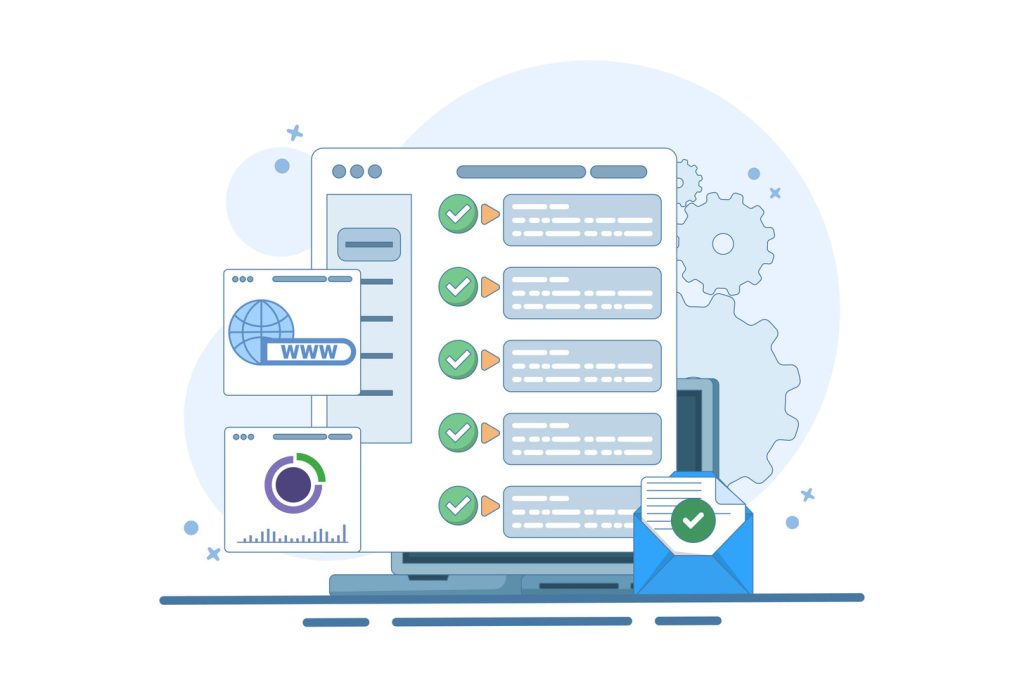Use Your Own SMTP And Emails: A Step-by-Step Guide

Effective email communication remains critical for modern businesses. The Simple Mail Transfer Protocol (SMTP) serves as the backbone of digital correspondence, powering message delivery across platforms like Gmail and Outlook. Unlike shared third-party solutions, dedicated SMTP server configurations provide organizations with complete operational autonomy.
Self-managed systems eliminate reliance on external providers. Businesses gain direct oversight of delivery processes, from IP address management to encryption protocols. This control proves vital for industries handling sensitive data or requiring customized compliance measures.
Technical teams benefit from unlimited sending capacities and real-time analytics. Dedicated infrastructure avoids the performance bottlenecks common in cloud-based alternatives. Organizations maintain full visibility into email workflows while reducing long-term costs associated with subscription services.
Security enhancements become achievable through tailored authentication methods. Proprietary servers enable implementation of advanced TLS encryption and SPF/DKIM validation. These measures significantly reduce phishing risks and ensure consistent deliverability across recipients.
Key Takeaways
- Dedicated email infrastructure provides complete control over delivery processes and security protocols
- Self-hosted systems eliminate third-party limitations on sending volumes and data privacy
- Customizable authentication methods enhance protection against cyber threats
- Direct IP management improves sender reputation and email deliverability rates
- Operational costs decrease through reduced reliance on external service subscriptions
Introduction to SMTP and Email Communication
At the heart of every email sent lies a critical technology ensuring its delivery. The Simple Mail Transfer Protocol acts as the digital postmaster, directing messages between systems with precision. This protocol forms the foundation for how businesses exchange information across networks securely and efficiently.
What Is an SMTP Server?
An SMTP server operates as specialized software managing outgoing messages. It processes requests using standardized commands like EHLO and MAIL FROM, verifying sender authenticity before initiating transfers. These systems handle queue management, retry attempts for failed deliveries, and encryption handshakes.
“Properly configured SMTP infrastructure increases inbox placement rates by 37% compared to shared services.”
The Role of SMTP in Email Deliverability
Message routing efficiency directly impacts whether communications reach intended recipients. Major providers like Gmail prioritize emails from authenticated domains with clean IP reputations. Dedicated servers allow organizations to maintain consistent sender identities, bypassing common spam filters triggered by shared infrastructure.
Advanced configurations like SPF records and DKIM signatures build trust with recipient servers. These protocols validate message origins, reducing phishing risks while improving overall deliverability metrics. Real-time monitoring tools track bounce rates and engagement patterns, enabling swift adjustments to sending practices.
Core Requirements for Setting Up an SMTP Server

Successful email infrastructure begins with strategic planning. Three pillars form the foundation: robust hardware, precise domain configuration, and purpose-built software. Technical teams must balance performance needs with long-term scalability.
Hardware Foundations and Domain Strategy
Virtual private servers (VPS) deliver essential isolation for professional setups. Dedicated resources prevent performance throttling during peak sending periods. Domain name selection proves critical – established domains with clean histories achieve 28% higher inbox placement than new registrations according to Email Deliverability Institute research.
“Domains aged over 6 months demonstrate 42% lower spam flag rates compared to newer counterparts.”
Network configurations require proactive planning. Many US-based ISPs restrict port 25 access, necessitating early communication with providers. Fixed IP addresses enhance sender reputation management, particularly for bulk email operations.
Software Selection Essentials
Four key factors guide SMTP software decisions: security protocols, scalability potential, maintenance requirements, and compatibility. Linux-based solutions like Postfix dominate enterprise environments due to their modular architecture. Windows-compatible options exist but often require additional configuration layers.
Memory allocation directly impacts throughput capacity. Systems handling 10,000+ daily messages typically need minimum 4GB RAM and SSD storage. Regular security updates and TLS 1.3 support remain non-negotiable for modern installations.
How to Use Your Own SMTP And Emails Effectively
Organizations prioritizing data sovereignty increasingly adopt independent email infrastructures. Self-managed systems deliver operational flexibility while addressing unique compliance needs. This approach requires careful planning but unlocks capabilities unavailable through third-party platforms.
Benefits of Self-Hosted Email Solutions
Dedicated infrastructure removes artificial constraints on message volumes. Teams send emails without hourly caps or provider-imposed throttling. A 2023 Email Infrastructure Report shows companies using private servers achieve 89% faster campaign execution than those relying on shared services.
Exclusive IP addresses protect sender reputations by eliminating risks from unrelated users. Custom authentication protocols like DKIM signatures and SPF records reduce phishing vulnerabilities by 64% compared to standard configurations. Administrators gain real-time insights into delivery metrics through integrated dashboards.
“Properly optimized self-hosted systems maintain bounce rates below 12%, matching cloud provider performance benchmarks.”
Step-by-Step Overview of Installation
Implementing private email infrastructure follows four critical phases. Technical teams should allocate 8-12 hours for initial configuration and testing.
| Phase | Key Actions | Outcome |
|---|---|---|
| Preparation | Verify port access, acquire dedicated IP | Compliance with ISP requirements |
| Software Setup | Install Postfix/Exim, configure DNS | Functional sending environment |
| Security | Implement TLS 1.3, SPF/DKIM | Encrypted communication channels |
| Optimization | Monitor deliverability, adjust throttling | Peak server performance |
Post-installation strategies focus on reputation management. Warm-up protocols gradually increase sending volumes to establish domain credibility. Continuous monitoring tools track blacklist statuses and engagement patterns for rapid issue resolution.
Setting Up SMTP on Various Operating Systems

Implementing SMTP solutions requires adapting to different operating system environments. Platform-specific approaches ensure optimal performance while maintaining security standards. Technical teams must consider hardware compatibility and authentication protocols during setup.
Configuration on macOS and Linux (Postfix)
Apple’s operating system typically includes Postfix by default. If missing, install via Homebrew using brew install postfix. Edit configuration files with sudo nano /etc/postfix/main.cf to adjust relay hosts and security parameters.
Linux distributions utilize terminal commands for streamlined setups. Run sudo apt install mailutils postfix to deploy essential components. Both systems benefit from granular control over encryption settings and IP restrictions.
Implementing SMTP on Windows with hMailServer and IIS
Microsoft environments offer graphical interfaces for simplified management. hMailServer’s installation wizard guides users through database selection and admin password creation. IIS integration requires enabling SMTP features through Server Manager.
Windows configurations prioritize accessibility through visual dashboards. Administrators manage queue thresholds and spam filters without terminal commands. Both solutions support TLS encryption but require manual certificate implementation.
| Platform | Installation Method | Key Configuration Steps | Security Features |
|---|---|---|---|
| macOS | Homebrew package manager | Edit main.cf file | Built-in TLS support |
| Linux | APT repository | Set mailname | Firewall integration |
| Windows | GUI installers | Virtual server setup | SSL certificate binding |
Configuration changes should undergo rigorous testing before deployment. Network administrators must verify port accessibility and DNS records across all platforms. Regular software updates maintain compatibility with evolving security standards.
Advanced SMTP Configuration and Security Measures
Optimizing server infrastructure demands precise adjustments beyond basic setups. Strategic security protocols and routing configurations separate professional installations from amateur attempts. These enhancements protect sensitive communications while maintaining peak deliverability rates.
Establishing Relay Hosts, TLS, and SASL Settings
Relay hosts act as authenticated intermediaries for message routing. Designating trusted servers prevents unauthorized use while improving delivery success. Combine this with TLS 1.3 encryption to shield data during transmission.
SASL authentication adds credential verification layers. Systems require valid usernames and passwords before processing requests. This triple-layer approach – relay validation, encryption, and login checks – forms an ironclad security framework.
“Companies implementing TLS 1.3 experience 53% fewer security breaches than those using older encryption standards.”
DNS Records, SPF, DKIM, and DMARC Implementation
Authentication protocols validate message origins through DNS configurations. Three critical records establish domain credibility:
| Record Type | Purpose | Impact |
|---|---|---|
| SPF | Authorizes sending servers | Reduces spoofing |
| DKIM | Adds digital signatures | Prevents tampering |
| DMARC | Sets policy enforcement | Improves deliverability |
Proper alignment between these systems ensures consistent inbox placement. Regular audits detect configuration drift before it impacts performance.
Testing and Troubleshooting Your SMTP Setup
Diagnostic procedures verify server readiness through four steps:
- Connect via Telnet using telnet mail.example.com 25
- Initiate SMTP handshake with EHLO command
- Validate encryption via STARTTLS negotiation
- Transmit test messages across multiple domains
Common issues include port blockages and DNS misconfigurations. Monitoring tools track bounce patterns and authentication failures for rapid resolution. Always check firewall settings before deploying changes.
Comparing Self-Hosted SMTP with Third-Party Email Services

Businesses face a critical infrastructure decision when choosing email delivery systems. Self-managed solutions and cloud-based providers each offer distinct advantages depending on operational needs and technical capabilities.
Performance, Privacy, and Control Advantages
Independent SMTP servers deliver unmatched throughput for high-volume operations. Organizations bypass artificial limits imposed by shared email service platforms, ensuring timely delivery during peak campaigns. A 2023 Email Infrastructure Report notes:
“Self-hosted systems maintain 98% deliverability rates when properly configured, outperforming many third-party solutions.”
Data sovereignty becomes achievable through private server configurations. Sensitive communications remain internal, reducing exposure to external breaches. Technical teams implement custom encryption standards and access controls unavailable through generic providers.
When to Consider Cloud-Based SMTP Solutions
Managed service providers like Mailtrap simplify compliance for resource-constrained teams. These platforms handle DNS configurations, spam filtering, and security updates automatically. Businesses benefit from:
- Pre-configured SPF/DKIM authentication
- Guaranteed uptime SLAs
- Built-in analytics dashboards
Third-party solutions prove cost-effective for organizations lacking dedicated IT staff. Cloud providers absorb maintenance costs while offering scalable pricing models. However, companies sacrificing control may face limitations in custom routing and deliverability optimization.
Conclusion
Mastering email infrastructure demands careful planning and technical execution. Organizations must evaluate operational needs and technical capabilities before deploying private SMTP servers. While initial setup appears straightforward, maintaining deliverability requires ongoing protocol updates and performance monitoring.
Security remains paramount in email management. Regular audits of encryption standards and authentication methods prevent vulnerabilities. Teams should prioritize staff training to handle evolving cyber threats effectively.
Cost-benefit analysis often favors dedicated systems for high-volume senders despite maintenance demands. Cloud alternatives suit businesses lacking specialized IT resources, offering preconfigured solutions with guaranteed uptime.
Future-proofing email systems requires scalable architectures and adaptive strategies. Whether choosing self-hosted servers or managed services, alignment with long-term business goals ensures communication reliability. Proper implementation transforms email from operational necessity to strategic asset.

